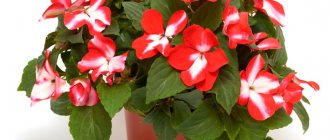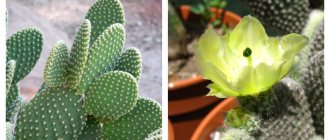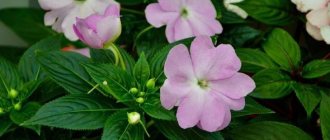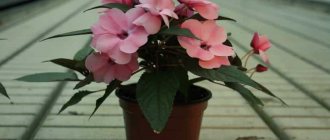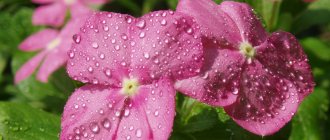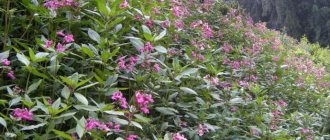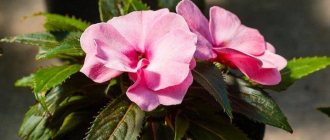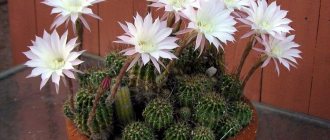History and description
There is no exact information regarding the origin of balsam. It is only known that its homeland and habitat are the subtropics of North America and Africa. Impatiens was brought to Europe in 1596, after which it gained great popularity. Waller's terry balsam is considered the most decorative. He is the “parent” of many hybrids. Impatiens is a perennial plant, but is often cultivated as an annual.
Waller's balsam is different:
- Abundant flowering.
- Juicy, brittle branched stem up to 60 cm high.
- Reddish-brown leaves.
- Shoots are 30 cm long.
Inflorescences appear early. Flowering lasts throughout the year. There are so many flowers that they cover all the leaves. The flowers are 5 cm in diameter. They are solitary or collected in inflorescences. They consist of 5 sepals and a five-membered corolla, connected in pairs or individual petals.
The peduncle is long. The fruit is a capsule. The root system is powerful and grows into drainage holes when there is not enough space.
Soil requirements
To plant ampelous balsam, you need to prepare a loose, slightly acidic substrate . You can prepare it if you take the following components in equal quantities:
- peat;
- vermiculite;
- leaf soil;
- river sand.
Ready-made soil composition can be purchased at the store. Before using it, put some sand in the pot. It is necessary to quickly remove excess moisture from the soil. If this is not done, the root system of young plants will rot.
Appearance and features
Balsam belongs to the balsam family. The leaves have wavy edges and droplets form at the tips when humidity is high. The flowers are located in the axils of the leaves and have a variety of colors:
- White.
- Red.
- Orange.
- Lilac.
- Pink.
The flowers are bicolor and have a spot in the central part. There are terry hybrids with multi-colored leaves. The crop blooms from early June to late September in open ground.
At the end of flowering, green fruits ripen, from which seed pods are formed. Balsam has a peculiarity: if you touch a dry box, the seeds scatter to the sides.
This beautiful and unpretentious plant has many varieties and is actively used for growing both at home and in the garden. Below you will find descriptions, characteristics and features of growing such species: Garden, Wild, New Guinea, Tom Samb, Ferruginous or Zheleznokosny.
Photo of the plant
Here you can see a photo of balsam:
Varieties
Thanks to the intensive work of breeders, many varieties and hybrids of ampelous balsam have appeared, which differ in size, color of leaves and flowers.
Among the most common varieties are the following.
| Name | Description |
| Tumbler White | The flowers bloom with a diameter of 4-5 cm, their color is white. |
| Atena Coral Pink | Terry inflorescences are scarlet in color, their diameter is the same as that of the previous variety. |
| Scarlet | The flowers are painted red and are 4-5 cm in diameter. |
| Atena Red Flash | The color of numerous flowers is red with white splashes. |
| Tumblr Rose | The bush is decorated with pink flowers. |
| Violet Star | The dark pink inflorescences have white stripes that extend from the center of the flower and continue to the middle of the petal. |
| Wallera Athena Appleblossom | The diameter of the flowers is from 4 to 5 cm, the outer side of the petals is white, and the inner side is painted pink. |
| Tumbler Salmon | The flowers are salmon-colored, their diameter is from 2.5 to 3.5 cm. |
Landing
Lighting and location
When planting a crop in open ground, you must choose a sunny , slightly shaded place. At home, balsams are placed on eastern and western window sills.
Reference. Impatiens is unpretentious to lighting and can even grow in the corner of a room.
Soil requirements
Planting of ampelous balsam is carried out in a loose and slightly acidic substrate. Acidity within 5.8-6 pH. To prepare the soil mixture yourself, take the following components in equal quantities:
- River sand.
- Leafy soil.
- Peat.
- Vermiculite.
You can purchase ready-made substrate at a flower shop.
Rules
Seeds are prepared for seedlings in mid-March. They are pre-disinfected in a solution of potassium permanganate. Algorithm for planting seeds:
Prepare containers with substrate and place planting material at a distance of 2-3 cm from each other.- Press the seeds a little into the ground and sprinkle with sand.
- Lightly water the soil.
- Cover the container with seedlings with glass or film to retain heat.
The container with seedlings is placed in a warm place with diffused light. Temperature for germination is +20-25 degrees. Direct sunlight is harmful to balsam.
Every day you need to remove the glass or film for ventilation. Make sure that the soil does not dry out. When 3 leaves appear, seedlings are picked.
Choose a pot that is not too large. Balsam feels comfortable even in cramped spaces. Drainage must be placed in the container - for example, expanded clay. Pour the substrate and place the seedling.
After planting, the plant requires daily watering. Waller's balsam and its hybrids are heat-loving crops. Planting in open ground is carried out no earlier than June-July. The seedlings are placed at a distance of 25 cm from each other.
Lighting and location
Attention! The flower is unpretentious to lighting. It can grow quietly even in the corner of a room. But it is possible to achieve abundant and constant flowering only if there is bright light.
You should not keep the flower on a south-facing window at the height of summer , or you should provide it with protection from the scorching rays of the sun. East and west windows are perfect. In summer, take the balsam out onto the balcony.
A flowering plant will be an excellent decoration for the garden, but it should not be planted in full sun. Light partial shade is suitable.
Flower care
In room conditions
Impatiens love moderate humidity. In hot weather they need to be sprayed so that the flowers do not fade.
Important! Water should not get on the flowers. Only the leaves are sprayed.
The temperature in summer is plus 25-26 degrees. In winter - no lower than plus 10-12 degrees. Temperature conditions cannot be changed suddenly if flowerpots with plants are in the garden. They are brought into the house before the cold weather sets in. Ampel balsams need bright sunlight, but they must be protected from direct rays to avoid leaf burns.
Irrigation features:
- Moisturize twice a day - morning and evening.
- Use only settled or boiled water. Definitely warm.
Do not allow the soil ball to dry out. If the soil is dry, place the container with the flower in a large bowl of water and leave until the soil gets wet.- In summer, provide abundant watering, in winter - reduce moisture.
- Make sure that there is no stagnation of water - the root system will begin to rot.
If there is a lack of liquid, the development of balsam slows down , the flowers fade and fall off.
Decorative crops are fed every 2 weeks from April to August. Use special fertilizers for flowering plants. For example, Kemira. It contains iron, copper, potassium, phosphorus, magnesium. For abundant flowering, use Cristanol once a week (1 tbsp. l / 5 l of water).
Garden balsam: description of the plant
This plant is also found in the wild.
There are also many varieties bred by breeders. Therefore, you can find low-growing bushes, barely reaching 20 cm, and plants 70 cm high (and sometimes from 1.5 to 2 m). The second difference between the varieties is color. Nature has practically used the entire spectrum of shades, which allows you to decorate the area with a bright patterned “carpet”. The same variety of colors is observed in the foliage - from bronze-purple tones to green.
The inflorescences have a pyramidal or spherical shape. Otherwise, the cultural characteristics of the species are the same:
- it is a long-flowering bush;
- its branched stems are smooth, succulent, but brittle at the nodes;
- balsam is characterized by foliage;
- the length of the lanceolate (sometimes oval) plates ranges from 8-12 cm;
- fleshy leaves with jagged edges are arranged alternately on the stem;
- Large, irregularly shaped inflorescences “sit” in the leaf axils.
Budding occurs at the end of spring, and the fragrance of the flowerbed lasts until mid-autumn. Then oblong five-chambered achenes are formed on the bush. When the time comes to release the seeds, they scatter throughout the area within a radius of 2 meters. But a mature capsule can react with a similar action to the slightest touch to it. Therefore, the flower received another name - “Touch-me-not”.
Classification
Garden balsam is divided into 3 main groups:
- traditional plants with spreading branches; They are characterized by green foliage and red, pink, white shades of flowers;
- medium-sized compact hybrids with purple, orange, pink, red, white inflorescences;
- New Guinea hybrids with variegated leaves.
Among each species you can find one- and two-color plants, as well as double ones, which, in turn, are divided into pink-like, camellia-like and carnation-like.
According to the direction of branch growth, balsams are divided into erect, bush, and hanging. Among the low-branching plants, bouquet-bush plants (up to 40 cm in height) and dwarf plants (up to 25 cm) stand out.
Popular varieties of balsam
Waller's balsam
Waller's balsam. A medium-sized compact bush with a lush, spherical crown and bare, highly branched stems. The shiny thin leaves have different colors (depending on the hybrid). Large double or single flowers are formed at the tops of the stems and vary in shades from white to purple. There are two-color varieties.
Tumbler Salmon
Tumblr Salmon. Refers to ground cover with a large number of branching shoots. It can develop in hanging flowerpots. Large, varied inflorescences delight the eye with bright colors throughout the year if grown indoors.
Tom Thumb
Tom Thumb. The heavily branching bush reaches a height of 25 cm. Large double inflorescences form on it. The stems are well leafed with delicate plates.
Camellia
Camellia. An excellent variety for mixborders and flower gardens. In comfortable conditions, the erect stem grows up to 1 m. It produces beautiful large double flowers. Grown exclusively by seedlings, as they are afraid of spring frosts
It is worth paying close attention to the New Guinea group of hybrids. These are compact bushes with flowers of various colors.
Plants tolerate drought well and adapt well both in sunny meadows and in the shade. They are characterized by continuous flowering.
Balsam New Guinea
At home and in greenhouses, the species is grown as a perennial. Popular varieties include “King Kong”, “Super Elfin”, “Rosette”, “Tango”, “Symphony”, “Fiesta”, “Java”.
Transfer
The culture is transplanted into another pot when the root system does not fit into the drainage holes. The procedure is carried out in April or May. If the rhizomes feel comfortable, it is not necessary to replant the plant. After replanting, pruning is done: long stems are shortened and the tops are pinched.
In the open ground
Rules for caring for garden balsams:
- Regular watering in the evening, especially in the heat.
- Mulching the soil to retain moisture.
- Weeding and removing wilted flowers.
Phosphorus and potassium fertilizers are applied twice a month and fed with an ash solution. It is advisable to use liquid fertilizer for the leaves. In order for the bush to have a beautiful shape, you need to regularly pinch the tops of young branches.
Before frost sets in, balsams are dug up and planted in a pot. They will continue to bloom at home. At the end of budding, the shoots are cut off and the plant is placed in a cool room with a temperature of no more than + 15 degrees. The dormant period lasts during January and February. At the end of February, shoots already appear on the balsam. The flower is watered intensively and transferred to warmth.
Sowing at home
Loose soil is poured into containers; it needs to be leveled and moistened, however, there is no need to compact the soil. The seeds are poured onto the surface of the soil (not thickly); the optimal distance between them is 4 cm. Chandelier balsam, just like Waller's balsam, needs light. The seeds are placed on top of the soil and covered with a small amount of sand. Alternatively, use sifted soil.
The seeds should not be completely covered with soil. After sowing, you should moisten the soil: use a spray bottle. The seeds are covered with a loose transparent film: they will grow within 2 weeks. After a week, you will see that some of them are sprouting and others are not.
First shoots
To get a sufficient number of seedlings, you need to place the seeds in a warm, bright place. They grow well if the air temperature stays within + 23 degrees. If you place the seeds in a cool room, they will not grow well. Containers should be placed in a bright place, but young seedlings should not be exposed to “aggressive” rays of the sun.
The soil should not be dry. But if you simply cover the seeds and forget about them for a week, future seedlings will get sick.
Seeds should be ventilated. The film should be lifted every day for 7-10 minutes. In a couple of weeks you will see small seedlings. In order for them to grow better, it is necessary to lower the humidity level in the room, and increase ventilation to 20 minutes. At this time, it is not recommended to remove the film: the plant will gradually get used to the new conditions.
At first, the film lifts slightly, then after 4 days you will need to completely remove it. The temperature drops gradually, eventually it should reach +16 degrees. The seedlings are placed in a cool room. It is important to spray the soil periodically. If the growing season is slow, you can carefully treat the seedlings with a weak urea solution.
Diseases and pests
In winter, impatiens is susceptible to fungal diseases, gray mold in particular. The plant is removed from the pot, the roots are cleaned and transplanted into another container with a new substrate.- At elevated temperatures and low humidity, flowering stops and the leaves wither. Dry indoor air causes buds to fall off. Lack of light affects the color of the leaves. Impatiens lose their decorative appearance - the shoots become very elongated.
- Bacteriosis (watery spots on shoots and leaves) develops due to contaminated, over-fertilized soil; high temperature. Spots cover all the leaves and the plant dies. You need to fight the disease at the first signs. The flower is sprayed with Bordeaux mixture.
- If the room humidity is low, the flower may be affected by spider mites. The leaves curl and fall off over time. To combat the pest, the drugs Neoron and Actellik are used. The appearance of whiteflies is signaled by yellowing of the leaves. Treatment is carried out by Fufaron, Decis.
To prevent diseases and pests, you should adhere to the above rules for caring for the plant.
How to rejuvenate a plant
And you can rejuvenate it by cuttings. To do this, strong, good stems 8-10 cm long are cut and rooted in water or moist soil with the addition of sand for looseness. In just a few days, roots will appear.
A plant grown from a cutting cannot be replanted. Unfortunately, the life span of balsam is short. Blooming all spring and summer, by autumn the balsam already loses its decorative effect and needs to be renewed again by cuttings.
Despite the lengthy article, the balsam does not require excessive effort. A couple of seasons and you will be able to determine by eye what your plant needs in order to once again enjoy a flowering carpet. And your pleasure is guaranteed.
Features of reproduction
Balsam is grown from seeds or propagated by shoot cuttings. Vegetative propagation consists of the following actions:
- Choose a healthy shoot 8-10 cm and cut it with a sharp knife.
- Place the cutting in a container with water and place it in a bright place - on a windowsill.
- After the roots appear, the cuttings are planted into small containers (10 cm in diameter).
When rooting is carried out in the spring, a flowering plant will form from the shoot in the summer. During autumn rooting, more heat and light will be required.
Thus, ampel balsam is an unpretentious decorative crop. It is grown at home in pots. At the beginning of summer, you can plant it in the garden in a semi-shaded area. With the onset of cold weather, the plants are dug up and transplanted back into the pot. In order for balsams to bloom wildly, it is important to follow the rules of care. You cannot replant the crop during flowering and place it near heating appliances.
What to do next?
Above it was described in detail how to grow balsam seedlings from seeds. But that is not all. Next, she needs to provide proper care. The first shoots usually appear after 3 weeks. As soon as this happens, the film or glass can be removed from the pots. If necessary, artificial lighting is installed for seedlings. As it grows, soil is added to the container, and it is also irrigated from a spray bottle with settled water at room temperature.
But it is very important not to overdo it with moisture, since its excess can lead to rotting of the rhizome and death of the flower. It is best to water every evening after dusk.
If the weather is cloudy and rainy, the intensity of watering is reduced.
If we grow balsam seedlings ourselves, we need to monitor the level of salts in the soil. Their excess can lead to various undesirable phenomena. The presence of problems can be guessed by the appearance of a white coating on the surface of the substrate. If this happens, the only way out is to replant the plant and completely replace the soil. You can avoid excessive salt accumulation by using desalinated or rainwater for irrigation.
As soon as the seedlings reach a height of two centimeters and two full-fledged leaves are formed on them, they can be planted in separate cups. To speed up growth, the tops should be pinched. Planting in open ground can be done only after a well-developed root system has been formed and the seedlings have become small bushes.
Collection of seeds and their selection for sowing
The plant actively spreads by self-seeding. Balsam seed pods literally explode, open at any touch, and the plant generously self-sows. If left unchecked, impatiens can easily turn into a weed, but this feature makes it very difficult to collect seeds. This should be done at the stage when the bolls begin to whiten, and it is better to tie the fruits with gauze or a piece of transparent fabric in advance to prevent spillage.
Balsam seeds retain their viability for a very long time, up to 8 years. Therefore, when buying seeds, it is not at all necessary to look for the freshest ones. Moreover, if the summer is rainy and it is not possible to collect seeds, you can use stocks of your own seeds from previous years without an additional germination test.
Sowing seeds
When the basic preparations are made, you can begin propagating balsam by seeds.
The ideal sowing time is mid-March. In June it will be possible to admire the first blooming flowers of young impatiens.
When sowing, the seeds should be placed more spaciously and at an equal distance from each other to ensure uniform illumination for the seedlings.
Seeds should be sown shallow, gently pressing them into the soil with a damp toothpick, but not submerging them, so that the seeds receive enough light to germinate.
Next, you need to spray the crops with water and place the container in a plastic bag, filling it with air. A warm place and good lighting are an important component for successful germination. However, seedlings should be protected from direct sunlight.
The optimal temperature for seed germination is from +22 to +25 °C.
After about 3 weeks, the first shoots appear
During this time, it is important to adhere to the following actions:. Ventilate the crops as often as possible and shake off accumulated condensation from the greenhouse to protect the seeds from air stagnation and fungal infection
Ventilate the crops as often as possible and shake off accumulated condensation from the greenhouse to protect the seeds from stagnant air and fungal infection.
Moisten the soil with a spray bottle, avoiding both overdrying and waterlogging of the soil. Illuminate the seedlings with a phytolamp in the morning, evening and on a cloudy day.
When the first shoots appear, carefully pour damp soil onto the young bare roots.
When watering seedlings, it is important to ensure that water does not get on the root collar of the young plant to avoid rotting. Experienced gardeners advise using the “bottom watering” method, that is, pouring water into a tray on which a container with seedlings stands
Thanks to proper care, balsam seedlings develop quickly. When the first true leaves appear, you can pick the sprouts into separate containers. Small plastic cups work well for this.
It is important not to forget to make drainage holes in them and put a little expanded clay on the bottom
If the seedlings are too elongated due to lack of light, when picking, you should bury the lower parts of the long stems deeper. It is recommended to keep the glasses with small balsamins in the “greenhouse” for a little longer, gradually accustoming them to fresh air.
With sufficient lighting and regular watering, the seedlings become strong and stocky, beginning to bush early. If young plants do not want to branch, you need to pinch the tops to actively form side shoots. The more new shoots grow, the more magnificent the bush will grow and the more abundantly it will bloom.
When the young plants have grown noticeably and their roots have completely entwined the earthen ball, you can transplant them into new permanent pots and wait for the appearance of a bright scattering of delicate balsam flowers.
As you can see, growing balsam from seeds is not so difficult. You just need to follow some planting rules, as well as give the seedlings a little care and love - and a balsam garden with a colorful scattering of beautiful flowers will bloom in your home.
And for the most curious, we suggest you watch a video of growing balsam from seeds.
Balsam in landscape design
The brightness and variety of colors of the inflorescences make it possible to actively use balsam in decorating garden plots.
It is thanks to the ability to bloom all season long that the plant can be used to create a real design by planting balsam according to a certain ornamental pattern. The richness of colors brings its own charm to the design of ridges, rock gardens, rock gardens, and rocky gardens. “Touch-me-not” feels comfortable not only in group compositions - single bushes will look good near gazebos and ponds. They can be planted at the entrance to the house and on the side of the entrance gate.
What flowers are combined with balsam in the flowerbed?
It is enough to have different varieties of this plant on hand to decorate the landscape with an original patterned carpet of flowers. Balsam also goes well with other crops. Most often you can see begonia and violet nearby. This combination creates a pleasant atmosphere. The bluebells look interesting against the background of “Vanka Wet”, and the boxwood looks unusual.
